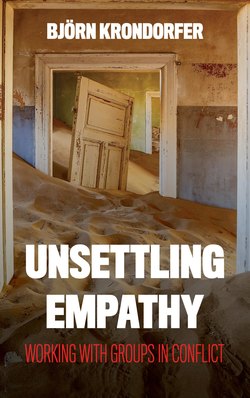Читать книгу Unsettling Empathy - Bjorn Krondorfer - Страница 8
На сайте Литреса книга снята с продажи.
Structure
ОглавлениеBecause there is no theory to be defended and no step-by-step method to be introduced, there is no ready-made order by which this book proceeds. Instead we may want to think of this writing as a layering of concepts, examples, and meaning, which gives this book a motion of circularity more than linearity. Such circularity, I hope, is not experienced as repetitiveness but an intensification of the materials presented.
The layering consists of three levels that have different explanatory and heuristic value. I will call these layers, respectively, “frames,” “dynamics,” and “approaches.”
“Frames” establish a broader context for explaining the materials and observations of this work. These frames command, organize, and focus the materials on which this writing relies, and they do so within established transdisciplinary fields. The frames most helpful for my work are “reconciliation,” “memory,” “trauma,” and “empathy,” and they are presented in the first part.
In the second part I explore the various dynamics and approaches that unfold and characterize my work with groups in conflict. “Dynamics,” here, refer to my observations of how conflicts surface and are expressed when working with people in adversarial relations. Dynamics are the kind of psychosocial, psychopolitical, and emotional forces we need to pay attention to when guiding people away from acting out and toward working through. These dynamics include, for example, the sway of large-group identifications and master narratives, the emergence of moral emotions, the courage to become vulnerable, attachments to collective history, the acting out of transgenerational obligations, or the ability to develop trust and relational empathy. Though this book focuses on how these dynamics positively affect groups in conflict, it will also introduce moments of disappointment and frustration. As these dynamics evolve in intergroup encounters, they can operate as stumbling blocks or building blocks.
“Approaches,” the third layer, are defined as the practical means by which the dynamics of a conflict can be articulated or made visible in particular intergroup encounters. Every facilitation relies on a set of techniques and exercises that have proven useful to a facilitator depending on his or her expertise and training. What we do in my workshops and seminars does not neatly line up with a standard method, which is why I prefer calling the practical components “approaches” rather than tools, techniques, or exercises. When I guide groups in conflict, these approaches are never devoid of content (as the terms “tool” or “technique” might suggest) but constitute an integral part of the process. Put differently, “dynamics” and “approaches” are inseparably tied to each other as they evolve together. What a particular approach can do is to vocalize, visualize, intensify, or mediate certain dynamics that either thwart or encourage the trust-building that is necessary for working through past and current agonies. Approaches introduced in this book include, among others, living sculptures, timelines, loaded words, witnessing circles, triangulation, memory objects, amplification, and the arts.
To assist the reader—and also provide a guide for the practitioner—I have included a glossary at the end of this book. The glossary contains those terms that I deem particularly helpful for my work. They include conceptual terms related to frames, analytical terms related to dynamics, and practical terms pertaining to approaches. When a glossary term appears in a substantial way for the first time in the text, it is marked with an *asterisk.
Reading this book, I hope, will inspire people to join those walking on a path of unsettling empathy for the sake of future generations.
